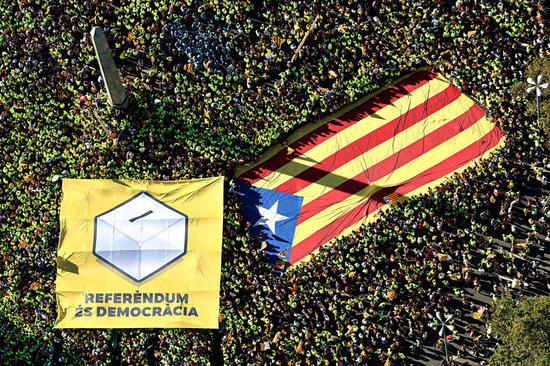A year by year guide to Catalonia's independence rallies
Every September 11 since 2012, Catalans have been taking to the streets demanding self-determination

2012: where it all began
In 2012, the pro-independence Catalan National Assembly (ANC) called the first September 11 demonstration. The motto of the rally was clear-cut in favour of Catalan independence: “Catalonia, new European state.”
A massive crowd attended the event, but figuring out the exact number of protesters proved controversial: according to organizers, it was 2 million; the Catalan government and local police said there were 1.5 million people; yet, according to the Spanish government delegation in Catalonia there were 600,000 protesters. This disparity in calculations has repeated itself every year since.
Shortly after the rally, former Catalan president, Artur Mas, travelled to Madrid to meet his Spanish counterpart, Mariano Rajoy, demanding a better fiscal deal for Catalonia. Rajoy said no. Mas, the leader of CiU, the moderate party which ruled Catalonia for most of the time since democracy, started advocating for Catalonia’s right to self-determination. From then on, independence has been at the centre of political debate in Catalonia.
2013: a 400 km human chain
ANC and Òmnium Cultural joined forces to organize a logistically-challenging rally inspired by the 1989 Baltic Way, in which people joined hands across Estonia, Latvia and Lithuania to protest against the USSR. Catalans formed a 400 km human chain that connected the Northern and Southern borders of the country. Figures estimated that 1.6 million people participated in the protest.
2014: the largest rally to date
Two months before the non-binding November 9 vote on independence, a ballot box became the epicenter of the largest demonstration to date. According to the police, 1.8 million protesters attended the rally. People wore yellow and red t-shirts and aligned themselves in two of Barcelona’s major streets, Gran Via and Diagonal, forming a giant V with the colours of the Catalan flag. At 5:14 pm (17:14, symbolizing the year when Catalonia was defeated by Spain in the Succession war thus losing its political independence), a girl put a vote inside the ballot box.
2015: the values of the Catalan republic
This time, protesters carried pointed banners. There were ten different sections, each with a different colour that was, according to organizers, aimed to represent a different value of the future Catalan republic. For instance: social justice, solidarity, culture, democracy and sustainability. Figures estimated attendance for this protest at some 1.4 million protesters.
2016: it’s not only Barcelona
In a decentralized demonstration, protesters travelled to five different cities across Catalonia: Berga, Barcelona, Lleida, Salt and Tarragona. Again, each city was supposed to represent a different dimension of Catalonia. According to the police, attendance was much lower, and protesters amounted to over 800,000.
2017: run-up to the referendum
1 million people turned out, according to figures, to celebrate Catalonia's national day in 2017. Less than three weeks before the historic October 1 referendum on independence, it was known as the 'Diada del Si' the 'National Day of Yes,' referring to what some hoped would be the outcome of the vote. Hundreds of buses brought protesters from all around the country wearing yellow shirts for independence. A minute of silence was observed in memory of the victims of the Barcelona and Cambrils terrorist attacks, and memorable moments also included giant pro-independence banners being passed along over the massive crowd. The shape of the demonstration was at the intersection of major roads, and seen as a 'plus' sign.
2018: what to expect?
One of the key themes for this year's pro-independence protest is to make the situation in Catalonia internationally known – and to give support to incarcerated leaders. This year's event will indeed be different than in previous years, as it will be the first since last autumn's independence bid, which led to a referendum and a declaration of independence in Parliament on October 27. That led to the imposition of direct rule on Catalonia, the firing of the government, the jailing of officials involved in organizing the referendum, while other political leaders avoided arrest by going abroad, where some still remain, including former president Carles Puigdemont. Support for those officials who are unable to return or who are awaiting trial will be a main focus of Tuesday's demonstration. Over the weekend, president Quim Torra called on the public to make September 11 this year, "historic."